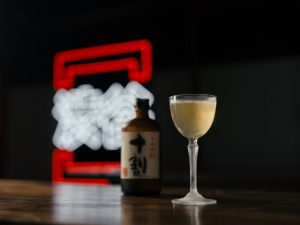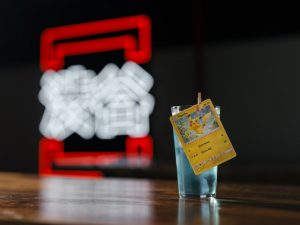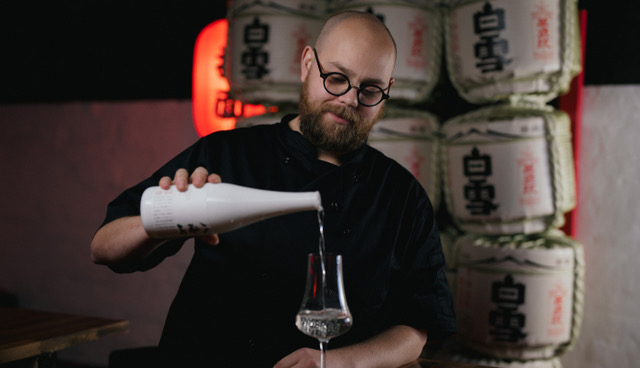Samuel Boulton of Kokushu Creative explores the virtues of mixing with Shochu.
With pretty much every decent London and New York bar playing with Yuzushu, Soy or Miso on their menu, there is no doubt in anyone’s mind Japanese spirits and ingredients are a hot topic right now.

Perhaps the biggest thing in mainstream Europe is the predominance of Japanese whisky, with every man and his dog scrambling to create a new brand to export overseas. Whisky is the tip of the iceberg in terms of what Japan has to offer, and, for me, the tip was never enough. I became bored of mixing with whisky many years ago, and wanted to explore the lesserknown side of booze found Shochu. Shochu caught my eye a few years ago when customers requested it in my Japanese Sake bar. It took some time, some books and a ton of googling but eventually I fell in love with it, its history and its culture.
Shochu is a complex category with rules, regulations and of course plenty of misunderstanding. If you’re a Shochu aficionado forgive me if I take liberties and oversimplify some things, I want people to actually read this article. I won’t talk about historical consumption and mixing here, but don’t overlook that. An Oyuwari with an amazing umami driven Sweet Potato Shochu, trust me, it’ll blow your mind.
Pronounced Sho-Chew, Shochu is indigenous to Japan but, before we talk Shochu, we need to talk Koji. Without Koji we don’t have Shochu, Koji is the key to making authentic Japanese Shochu. Koji is very misunderstood within the On-trade, I’ve seen bartenders use Koji as flavouring or mixed into a cocktail as an ingredient. Koji is a mold, typically gown onto rice, barley or sweet potato, that creates enzymes to start the saccharification process (conversation of complex starch into simple sugar). Similar to the malting of barley in Scotch production. That being said Koji does a lot more than just scarification, one thing is producing protease, which will convert proteins into Amino Acids. Amino acids are where the coveted ‘Umami’ flavour lies and this is why Shochu can be so exciting.

It’s also worth noting Koji is the catch all for many different Koji-Kin spores, most simply differentiated by their colour, Shochu mostly uses white Koji, Awamori black Koji, and Sake typically uses yellow Koji. This isn’t a hard and fast law, but a rule of thumb worth knowing. I think it’s good to start by talking a few things Shochu is not: Shochu is not Japanese Vodka – Shochu has the inclusion of Koji.
Shochu is not high strength sake – Shochu is distilled, sake is not. Shochu is not Soju – Soju is like Shochu’s Korean relative who they hate bumping into at the supermarket. Soju (for the most part) is a multiple distilled spirit made from a cheap base ingredient like Tapioca or Potatoes, diluted with water, then has added flavourings and Sugar. It’s not to say Soju is bad, I love Soju, but its not Shochu.
So, what is Shochu? Shochu can be broken down into a many styles, and made with over 50 ingredients. I mention three styles below but this is in no way an extensive list. The most common Shochu are made using Sweet Potato, Barley, Rice, Sake Lees, Brown Sugar and Buckwheat. There are tons more including; Green Tea, Wasabi, Carrot, Kelp and even Milk! However, the later of that list is rarely seen, most common Shochu drank in Japan is made from Sweet Potato.

The first style to know is Korui Shochu. A Korui Shochu is multiple distilled and made to be cheap and tasteless. Great for infusing to make liqueurs or umeshu, commonly used for the base of a ChuHi (a Shochu Highball). Not something you’d sip and savour.
Honkaku Shochu is the beating heart of Shochu. Honkaku roughly translates to Authentic, has many rules to follow in terms of production, and its aim is to be a true representation of the base ingredient. What does that mean? When you drink a Shochu made from Rice, you taste Rice, from Barley, you taste Barley etc. To do this, Honkaku Shochu is single pot distilled. Single distillation means there is nowhere to hide for the producer so the attention to detail and care is unparalleled to anything I’ve seen before.
Shochu is perfect for western-style mixing. Whilst the ABV is lower than we expect to see here (most are around 25%) the variety in Shochu sets it apart from any other alcohol. Each base ingredient brings a unique character. Kokuto (Brown Sugar) is a great replacement for Caribbean Rum. Kome (Rice) can be used similarly to Vodka when you want something else in your drink to shine. Kasutori (Sake lees) Shochu is amazing if you want the famous ‘Ginjoka’, the characteristics of high quality sake.
Lastly, produced predominately on the island of Okinawa, Awamori is probably the popular Koji spirit from Japan (at least in the UK anyway). I could write a whole article on Awamori alone, but
the main takeaway is Awamori is made from Rice and uses Black Koji. This gives much bolder, stronger esters than White Koji which attracts us bartenders like flies to shit.
Mixing with Honkaku Shochu and Awamori is captivating. They contain a nuance of Japanese flavours rarely seen in western drinks. We’re not talking about simply adding Sesame, Yuzu or Wasabi to make your cocktail ‘Japanese’ but using Shochu to add a layer of complexity and umami.
Hara-Kiri
- 35ml Soba (Buckwheat) Shochu
- 20ml Boudier White Cacao Liqueur
- 15ml Tempus Fugit Banana Liqueur
Stirred over ice and serve up in your wankiest looking coup and garnished with (ideally) an
homemade dark cocktail spear.
This drink was a created as a collaboration between Samuel Boulton and Klára Kopčiková Designed to show the toasted wheat and rice notes from the Soba (Buckwheat) Shochu which perfectly pairs with the caramelised banana notes in the Tempus Fugit Banana liqueur.
Anime
- 20ml Kasutori Shochu
- 15ml Gabriel Boudier Lychee
- 10ml MUYU Jasmin Verte Liqueur
- 5ml Gabriel Boudier Blue Curacao Liqueur
- 20ml Acid Mix (Citric & Malic)
- 100ml Lemonade
Mix all still ingredients together in a tin and shake. Pour into a tall glass with ice and top with lemonade. Garnish with a first edition Charizard. This drink was a created by Klára Kopčiková.
This drink is based on the famous Japanese Chu-Hi. Chu-Hi is an abbreviation of Shochu Highball. Typically a light, fruity drink consumed straight from a can. Nothing like a Whisky Highball. This Kasutori Shochu is made using Daiginjo, Sake Lee’s, resulting in a very pronounced floral aromas which blend well with the fruit and floral notes added by the other ingredients.


